Lead Sensor Design
Although our simple lead detector will give some GFP output when lead enters the cell, we hoped to increase that GFP output with a genetic amplifier, represented by a black box in our diagram. With the amplifier part from the registry (BBa_J37015), lead enters the cell as before, activating the lead binding protein. The lead binding protein activates the lead promoter, which then activates our genetic amplifier. The signal goes through our genetic amplifier to give us a very large GFP output.
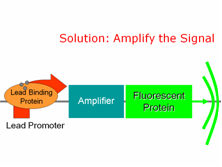
So how does the amplifier work? Well, notice the diagram below:
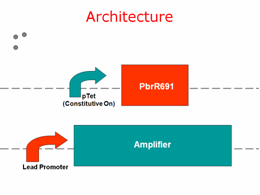
The orange parts are new parts that we have added to the registry: (a) The gene for the lead binding protein and (b) The lead promoter. The blue parts are existing parts in the registry.
The lead binding protein, PbrR691, is under control of a constitutive promoter pTet. This means that PbrR691 is always expressed, and a constant baseline amount of lead binding protein is always present in the cell, ready to go.
The lead promoter is placed before the amplifier part, which is placed before GFP.
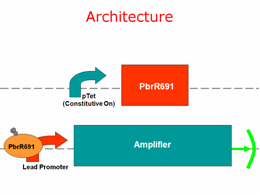
PbrR691 is constantly made at a baseline level under pTet control. It binds to lead that enters the cell, which activates the lead promoter. The signal activates our amplifier and gives us GFP output.
How does the amplifier actually work? Well, let’s remove the black box for a minute.
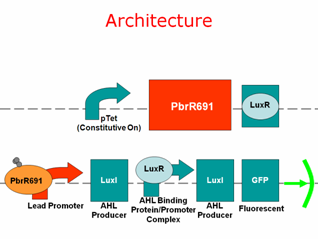
There are two amplification methods here:
(a) A positive feedback loop
(b) A cell signaling system that activates all the surrounding cells
The amplifier uses genes from a cell signaling system in Vibrio fischeri. These genes are commonly used in synthetic biology.
AHL = Cell Signaling Molecule
LuxI = AHL producer
LuxR = AHL binding protein
pLux = Promoter; requires both LuxR and AHL for activation
Now, when lead binds to the lead binding protein and the lead promoter becomes activated, we have production of the LuxI gene, which produces AHL. AHL can travel to other surrounding cells and activate their amplifier circuits in addition to the circuit being activated here, in this cell.
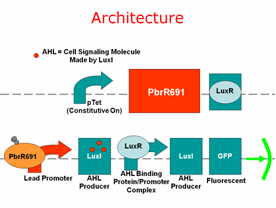
When AHL binds to LuxR (which like the lead binding protein PbrR691 is constitutively produced at some baseline level under pTet control), it activates the pLux promoter.
Another gene of LuxI follows the pLux promoter. Therefore, activation of the promoter by AHL simply produces more and more AHL in a positive feedback loop. More and more AHL is made, and it travels to the surrounding cells to activate their amplifiers even if they have not come into contact with lead. Continuous activation of LuxR and pLux, the AHL Binding Protein/Promoter Complex will give us more and more expression of all downstream genes: GFP.

Therefore, if we blackbox the entire diagram once again, we see that the amplifier uses positive feedback AND activation of neighboring cells to produce a much higher GFP output in response to lead:
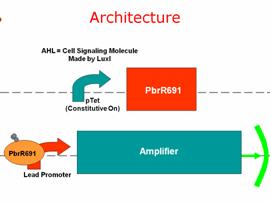
|